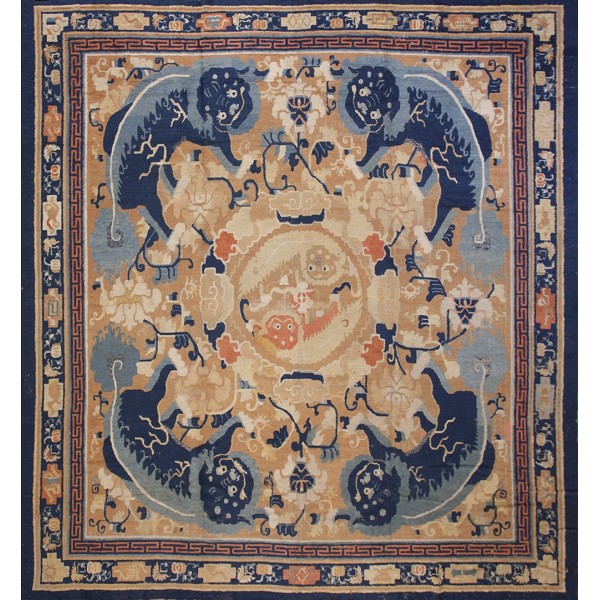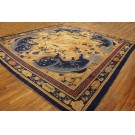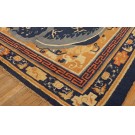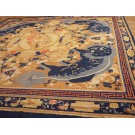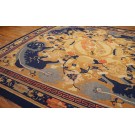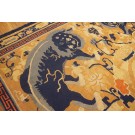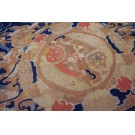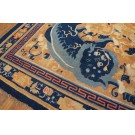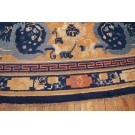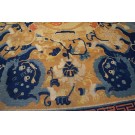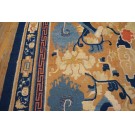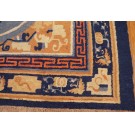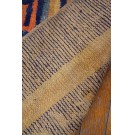18th Century Chinese Ningxia Main Hall Carpet with Foo Dogs
North Central China
First Half of the 18th century
Structural Analysis
Warp: cotton, white, natural, Z-4-S, hand-spun, very irregular in both individual strands and overall
Weft: cotton, white, natural, Z-4-S, hand-spun, winder plied, thick and very soft, two shoots equally wavy, alternating, P.6 wool, Z-2.3.4-S
Knot: Pl/0°/horizontal 6 x vertical 5 = 30 per square inch
Sides: 2 cords each of 2 body warps, weft wrapped figure-8 style
Ends: Partial Original
Wefts/Knots: 2 or 2+/1, thin knotting yarn, knot lines very irregular on verso
[n.b. check for T knots along edges]
Description and remarks
The corners of this now salmon (once red) ground square main hall carpet are marked by four, gigantic dark and middle blue lion dogs (over five feet long!). Two more dogs comprise a central roundel within a thick, polychrome cloud wreath. The rest of the field ornamentation consists of eight, large complete lotus palmettes, four additional fractional ones behind the corner dogs, and vigorous connecting vines and leaves, the latter primarily in dark blue. The two central dogs play with a brocade ball. There are, then, a total of six lion dogs.
[The dark blue main border…]
The four huge lion dogs are probably the largest on any surviving Ningxia carpet and are very finely detailed, with elements retained from much earlier prototypes. Each dog has a broad, leonine mane developing into an overpelt edged with split curls and a powder puff tail. There is a strong ivory backbone line from the neck to a volute in the tail. This line appears on the more dragon-like lion dogs in the well-preserved, magnificent Peking imperial late sixteenth-century carpet (7.85 m x 8.15 m), still in the Forbidden City [Carpets in the Collection of the Palace Museum, pp.XXX, ill.XXX]. The flaming joints on the latter dogs, a qilin feature, are also present in various later Ningxia carpet dogs, our 21376 among them, although here the front flames are reduced to small ivory veins or branches. In later rugs, or those with smaller dogs, the flames disappear entirely or are converted to limb contour outlines.
The dogs' faces and snouts are flat, but there are indications of teeth, even though the jaws are closed. The dogs are not barking nor do they hold in their mouths ribbons attached to brocade balls. There eyes are beady and lack eyelashes. They do not obviously protrude? as in certain other period examples [eg. Franses, pls.6,7,9]. While certain imperial dogs might be mistaken for dragons, these dogs are purely canine. Their ears are pointed and relatively short, and they lack the cloud-like involutions of the Beijing piece, cited above. Their manes are intended to be curly with scalloped outer edges, but lack internal detailing. Overall, the animals are fiercely playful, but not roly-poly pets. The dogs are grinning, not yapping.
The lion dogs of the central roundel are smaller and more schematic in design, partially because of the fading of the yellow to a buff-tan. Hence, details have been lost.
A published example with relatively larger corner dogs is the qilin and four dog rug [Franses, pl.6], 4.8 x 6.6, dated to the second half of the 17th century. The dogs here are more slender in body and each holds in its mouth ribbons connected to a brocade ball as in earlier imperial pieces. Their overpelts are far more simplified and schematic. The tails are very short with a distinct spiral. The selective fading has deprived us of many originally striking details in this small rug. Overall, the four corner dogs are proportionally smaller.
There are several idiosyncrasies in the large dogs of 21376. There is a dark blue and ivory speckled underside? to each dog and a similar area around the ivory tail volute. The feet of our dogs end in white puffs instead of detailed paws. The long, outstretched nearside back legs resemble those of [Franses, pl.6]. Our dogs have a dark blue hump in their lower backs. In some imperial pieces [eg. Franses, pp.24, 26-27], the hump is actually the top of the back offside leg and has flaming joint details. The effect has been converted into a convexity along the spine in 21376 instead of being off to one side. There are no flames issuing from the hidden joint.
The dark blue main border displays cartouches with various unrepeating antiques and precious objects: a fish, a square knot, scrolls, etc. Butterflies and small fruits* or paeonies with short, thin tendrils fill the interstices. The cartouches turn neatly at the corners. There is a "T" fret inner border with all four corners identically shaped, and a plain, dark blue outer band. The border is quite rare, appearing in smaller form on a daybed format rug, Sotheby's, New York, 7.4.99, lot 80, 5.5 x 8.3. Between the cartouches were stencil type lotuses with "M"-style tendrils.t. The rug was attributed, rather conservatively, to the mid-19th century. Given the close similarity of the borders, the rugs cannot have been made much apart chronologically and perhaps in the same workshop.
| Stock ID: | #21376 |
| General Rug Type: | Chinese |
| Specific Rug Type: | Chinese - Ningxia |
| Circa: | 1730 |
| Ground Color: | Camel |
| Border Color: | Navy |
| Origin: | China |
| Material: | Wool |
| Weave: | Pile - Knotted |
| Shape: | Square |
| Width: | 12' 8" ( 386 cm ) |
| Length: | 13' 4" ( 406 cm ) |
DescriptionChineseCarpets made in China proper. See entries Ningshia, Peking, Art Deco. Chinese - NingxiaThe western Chinese province of Ningshia has a mostly Muslim population and is the source of many of the oldest Chinese carpets of the modern (Ming Dynasty and later) era. The designs are typically Chinese: fretwork or Greek key boarders, pacony palmettes, bats, butterflies, Fu dogs, clouds, dragons, shou symbols, etc. Pollar carpets designed to wrap around monastery columns and displaying a dragon above waves are a specialty. The weave is coarse and soft, with several wefts between knot rows and a longish pile. Yellow golds, dark and light blues are common colors. The outer most plain border on pre 1800 examples is a corrosive brown. Formats include: large square throne carpets, paralleled meditation runners, chair seats and scalloped backs. | |
| Tearsheet Download | |
